

Medicine Through Time GCSE History. Medicine Through Time. Medicine Overview sort (time periods major scientists) Lesson Plan Medieval Medicine. Scream - The History Of Anaesthetics. Medicine through Time - Surgery. Medicine through Time - War. Medicine Through Time Bitesize Revision. Peer teaching grid A4. Medieval Medicine. Medieval surgery. Medieval medical knowledge. Medieval public health. Medieval doctors. AQA B1 3.6 Worksheet. AQA B1 3.3 Drugs. AQA B1 3.1 Worksheet. The History of Medicine. BBC Bitesize - KS3 History - Medicine through time. AliceOglesbyCrossNumberOrig. AN INTERVIEW WITH GALEN2000. Ancient Greece Medicine. Biographybooklet. Black Death Bingo. Cult of asclepios activity. DevelopmentsinSurgery. FIGHT AGAINST INFECTIOUS DISEASES REVISION. Historical Enquiry The Plague.
Historical simulations Document. Infectious Disease 1900. Jenner card sort vaccination. Jenner pics vaccination lesson. Medicine in the Renaissance. Medmedicine activitity patients. Medmedicine activity doctors. Medmedicine introduction. MiddleAges 1. Surgery in the Nineteenth Century. The change from supernatural to natural approaches to disease in the Ancient World and its impact on medicine before 1700. Vaccination lesson plan. WHAT was new in Roman medicine. Was taking medicine actually likely to make you more ill in the 19th Century? Was taking medicine actually likely to make you more ill in the 19th Century?
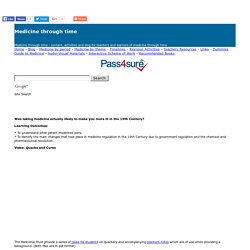
Learning Outcomes: * To understand what patent medicines were. * To identify the main changes that took place in medicine regulation in the 19th Century due to government regulation and the chemical and pharmaceutical revolution. Video: Quacks and Cures The Wellcome Trust provide a series of tasks for students on quackery and accompanying teachers notes which are of use when providing a background. (Both files are in pdf format) Patent Medicines Patent Medicines are reedies / cures for any kind of ailment. Activities: 1) Look at the adverts for Patent Medicines below. 2) Search the internet for images / adverts for patent medicines. What factors enabled the revolution in understanding about germs and vaccinations to take place? What factors enabled the revolution in understanding about germs and vaccinations to take place?
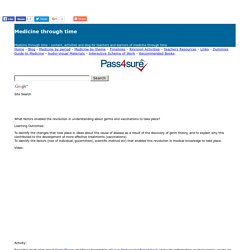
Learning Outcomes: To identify the changes that took place in ideas about the cause of disease as a result of the discovery of germ theory, and to explain why this contributed to the development of more effective treatments (vaccinations). To identify the factors (role of individual, government, scientific method etc) that enabled this revolution in medical knowledge to take place.
Video: Activity: Read this short page about Germ Theory and these biographies of Louis Pasteur and Robert Koch. Now consider the different factors that led to the discovery of Germ Theory and the improvements that followed its acceptance. Referring to the information on your timeline and on the pages you have already read through, complete this interactive diagram (from schoolhistory.co.uk) Further information about Pasteur and Germ Theory can be found on these sites: Pasteur from BBC History and on Pasteur and Koch. How confident could people be of good care in 19th Century hospitals? How confident could people be of good care in 19th Century hospitals?
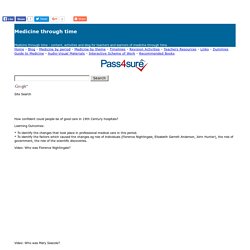
Learning Outcomes: * To identify the changes that took place in professional medical care in this period. * To identify the factors which caused the changes eg role of individuals (Florence Nightingale, Elizabeth Garrett Anderson, John Hunter), the role of government, the role of the scientific discoveries. Video: Who was Florence Nightingale? Video: Who was Mary Seacole? Activities: Public Health through the Ages. Introduction The creation of this exercise was the result of a conversation between Dan Moorhouse and Adam Henson, then a trainee teacher in his first week in school based training.
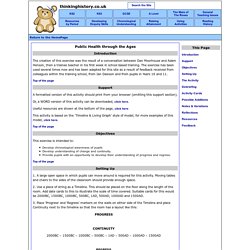
The exercise has been used several times now and has been adapted for this site as a result of feedback received from colleagues within the training school, from Ian Dawson and from pupils in Years 10 and 11. Top of the page Support A formatted version of this activity should print from your browser (omitting this support section). The Black Death: New Resources – ActiveHistory. History - British History in depth: Victorian Medicine - From Fluke to Theory. Change and Continuity in the Ancient World. GCSE Bitesize: Anaesthetics for pain. Simulating an Early Nineteenth-Century Surgical Operation. This activity, by Andy Harmsworth, helps students to get to grips with the surgery strand of SHP’s development study of medicine.
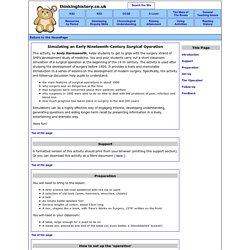
You and your students carry out a short classroom simulation of a surgical operation at the beginning of the 19 th century. The activity is used after studying the development of surgery before 1800. It provides a lively and memorable introduction to a series of lessons on the development of modern surgery. Specifically, the activity and follow-up discussion help pupils to understand: the main features of surgical operations in about 1800 why surgery was so dangerous at the time that surgeons were concerned about their patients’ welfare why surgeons in 1800 were able to do so little to deal with the problems of pain, infection and blood loss how much progress has taken place in surgery in the last 200 years Have fun!
Support A formatted version of this activity should print from your browser (omitting this support section). Preparation Go! Feedback.